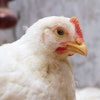
"Today, Butterball is the whole bird leader, it is the brand, and it is recognized as such," said Keith Shoemaker, president and CEO, Butterball. He explained that the goal for the Butterball management team is to make the Butterball brand just as successful in its other product lines–deli, tray pack, consumer packaged goods and foodserviceas it is in whole birds. "I don't know how many years this will take us, it won't be next year, but our ultimate goal is to be just as successful in all these different channels as we are in whole birds," he said.
A visit to Butterball LLC's new corporate office in Garner, N.C., served as the backdrop to a conversation with members of the Butterball management team about the company's progress since the merger of the former ConAgra turkey operations and Carolina Turkeys.
Butterball means celebration
Research conducted by Butterball has shown that consumers make an emotional connection between the Butterball brand and celebrations, according to Kerry Doughty, sales and marketing vice president, Butterball. Over the years, the connection made between the Butterball brand and family gatherings has created this association of the brand with celebrations. Butterball looks to capitalize on this connection with a marketing campaign that asks consumers to "celebrate everyday with Butterball."
Doughty said that Butterball is using this consolidated brand positioning to provide a single message which can be taken out to the consumer.
The company now has a unified sales force, where each sales person sells across all lines of products. "They are communicating the essence of celebration to the consumer for not just whole birds, but also for packaged goods, deli items and tray pack," Doughty said. "This way there is a single consistent message going to the consumer."
Butterball still has some deli and packaged processed chicken products. When asked about the potential for more chicken or pork products packaged under the Butterball brand, Doughty said, "At this time we believe that our foundation needs to be turkey-based and our expectation is that we will stay turkey-based. Our consumer knows us for turkey and we have a lot of room to grow turkey."
Butterball launched a new website on Oct. 1, and the company has revised its logo. New product packaging will be introduced in 2009, the color scheme will stay gold and blue, but packaging will incorporate the new logo and some revised messages for consumers.
Becoming more efficient
The former ConAgra turkey operation brought its successful Butterball brand along to the nation's largest turkey company, Butterball, LLC. Carolina Turkeys brought 20 years of experience as one of the industry's low-cost leaders. "Carolina Turkeys' foundation was as a low-cost producer with a highly utilized facility," Shoemaker said. "I don't expect the consumer to pay for our inefficiency. We have a big job to do taking the inefficiencies out of this operation. We have to be a marketing operation, but there is no reason we can't be a marketing organization that is also a low-cost leader."
The contrast between operating philosophies of the two organizations was most evident when looking at the slaughter plants. Carolina Turkeys' Mount Olive plant has two, two-inspector evisceration lines and has generally been fully utilized from a shackle time standpoint on two-shifts for years. Many of the former ConAgra slaughter plants only operated on a single shift per day, and some were only operated four days per week.
Reducing slaughter
Butterball recently announced that it will no longer raise or slaughter birds at the company's Longmont, Colo., plant. Cooking operations will continue at Longmont utilizing meat brought in from other plants. "The hardest thing that I have ever done is to close the Longmont operation because of its high cost," Shoemaker said. "It bothers me more than anything I have ever had to do, because we have 450 employees who won't have a job."
Longmont was Butterball's least efficient facility. Shoemaker said that live operations at Longmont were on company operated farms, not contract farms. Closing Longmont's growing farms lets Butterball cutback its slaughter without impacting its contract growers. Shoemaker said that one of the keys to the company's long-term success is the relationship that it has with its contract growers at its other complexes.
Butterball has no plans to replace Longmont's slaughter volume at its other plants, although it does have the shackle time available. Shoemaker said that Butterball's other plants have enough shackle time to slaughter 2.5 times the volume that was processed at Longmont. Heavy toms were processed at Longmont, and loss of this volume may change Butterball from a net seller of breast meat to a net buyer.
More cost cutting
A number of steps have been taken to help rationalize operations at Butterball and to reduce costs. Products and processes have been moved to plants where they can be produced most efficiently. In some cases that meant taking products that were being made on overtime at one facility and making them on straight time at another.
Butterball participated in a freight bid with Smithfield Foods, which is a 49 percent owner of Butterball. The bidding process yielded a new freight contract for delivering finished goods that netted savings of over $8 million. Shoemaker said that the company took $13 million out of transportation costs the year before by changing how they organize logistics and where they produced certain products.
On the live side, the company learned in its North Carolina operations that brood-and-move provided a strategy for raising toms that minimized growing costs and maximized pounds produced per square foot of housing. This strategy is now being implemented in the company's Midwest tom growing complexes. Shoemaker said that $100 million of operating costs have been removed since the merger, and that management is still working on reducing costs even more.
Ethanol and grain prices
Shoemaker said that only 20 percent of the cost increase incurred by turkey producers has been reflected in the market price for turkey so far. The turkey industry has begun cutting back on poult placements, and, eventually, these cuts will result in the full cost increases experienced by the industry flowing through to the consumer. "When the real cost of food is reflected in the price that consumers pay it will result in a reduction in the standard of living for the average American consumer," Shoemaker said. "They will have to cut back somewhere else so that they can pay for their food."
Pressure from consumers along with pressure from the food industry is needed to get Congress to revisit its ethanol policies, according to Shoemaker. Government subsidies and mandates have artificially impacted supply and demand for grains, and the government is the only entity that can correct this situation. He stressed that just because Congress and the EPA have not responded to calls to remove subsidies, tariffs and mandates favoring corn-based ethanol, that doesn't mean that the industry should stop asking the government to take steps to correct the problem.
"We have to be absolutely, positively relentless; we have to be like a terrier that is latched onto someone's ankle. I don't know if it will take two years or three years, but we have to keep after it, Shoemaker added. "We have to keep it human and speak with our legislators and let them know the human cost."





.png?auto=format%2Ccompress&fit=crop&h=167&q=70&w=250)












